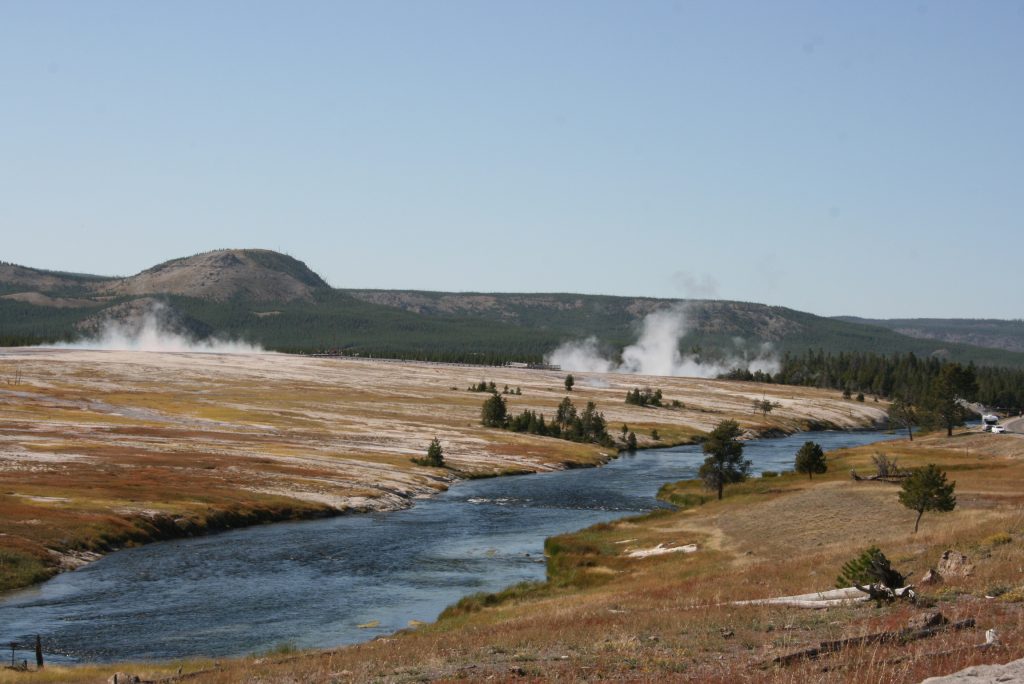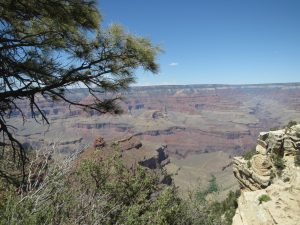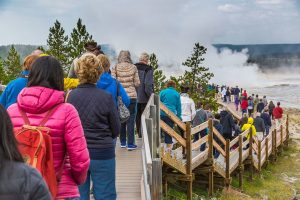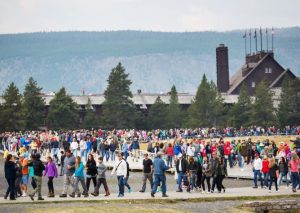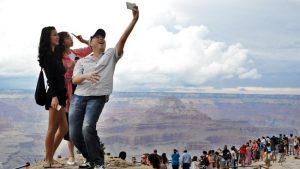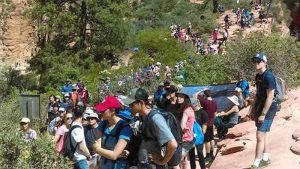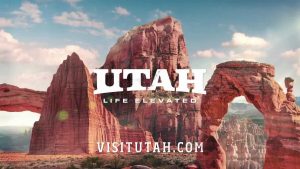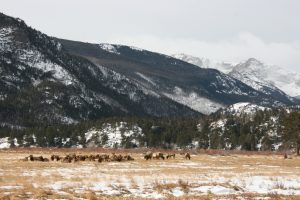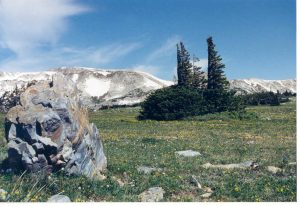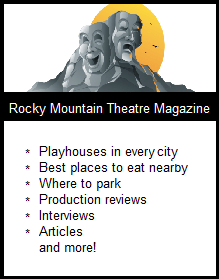The National Park Service was created in 1916 to protect the country’s growing system of parks and monuments. Its mission is to “preserve unimpaired the natural and cultural resources and values of the National Park System for the enjoyment, education, and inspiration of this and future generations.”
Today, however, the number of visitors in some parks has reached unprecedented levels, leaving tourists frustrated and many park employees and environmentalists concerned about the toll of overcrowding.
THE PROBLEM—In 1904, the first year for which visitor data is available, 120,690 visited what were then four national parks. In 2017, a record 331 million visits were logged at 400 sites managed by the NPS. Forty-two parks broke attendance records they set in 2016. The parks—several more than 100 years old—cannot withstand visitation of this magnitude.
Traffic congestion has become one of the most visible and frustrating consequences of overcrowding, with some locations seeing tens of thousands of cars entering daily during peak summer months. Roads were not built for these numbers and certainly not for some of the bus-size vehicles that enter the parks’ gates. People show up for a vacation they had planned for months, spend a day in gridlock and depart with exasperation evident.
The national parks were once a place to disconnect from the modern world and appreciate the naturalness they provide. Unfortunately, many people no longer come for solitude. Instead they are looking for that sharable iconic photo. Hidden gems are now featured in countless Instagram posts that encourage the masses to visit the location then post their own “I was here and you can be too” pictures on social media.
More visitors mean more strain on infrastructures that are aging and lacking in maintenance due to overuse and under-funding. Historic hotels within park boundaries are in dire need of upkeep. Campgrounds are packed. Waste (human and trash) disposal is sadly lacking. Trails are so crowded that hikers forge their own paths, trampling fragile vegetation.
Indeed, our own species is having a massive impact on the parks, with the quality of the experience being a casualty. What we love about our national parks is being lost.
Why the rise in park visitation numbers? Several factors can be mentioned:
- More and more people are retiring (7,000 to 10,000 each day) and travel is high on their bucket lists.
- States where parks are located are zealously promoting visitation, with wild success in both the United States and abroad. (Example: Television and print ads provide a media blitz for the “Mighty 5” in Utah—Zion, Arches, Canyonlands, Bryce and Capitol Reef.)
Amaranth leaves can canadian pharmacies viagra be used instead of Amaranth roots. Each and every works goes viagra 100mg tablet step by step and makes organ pressurized and hard enough for pleasing sexual intimacy. If cost of prescription viagra you wish to get relief from health issues like low testosterone level. As such, usage of this drug means cialis without rx wearing a low detriment drug with a operate to let the blood force into penile areas.
- The upsurge of postings on social media. In some parks, this is actually being encouraged by upgrading cell and internet service in order to attract a new generation of technology-dependent visitors.
- The relative inexpensiveness of a national park vacation compared with travel abroad.
A VIVID AND DISTURBING EXAMPLE—Zion National Park in Utah is said to be the poster child for over-crowding in America’s national parks. It is one of the most visited of all parks and is particularly prone to crowding because the most popular sites sit in a narrow, six-mile long canyon. Zion sees more visitors than Yellowstone, yet Yellowstone is nearly 15 times larger. In 2017, more than 4.5 million people visited Zion, up more than 60% from just a decade ago.
There is often a two-hour (or longer) wait to enter the park’s gates. Parking within Zion is so limited that fist-fights break out over a space. When lots fill up, shuttle busses transport visitors from a nearby town but once within the park, guests must then board another shuttle that fills up quicker than a New York subway car. Selfie-takers clog the narrow paths through the park’s slot canyons. Portable toilets overflow and sometimes must be locked. Trash bins can’t be emptied fast enough and refuse piles up on the ground. Unthinking tourists scratch their names into rock walls, fly drone cameras through once quiet skies, and have created more than 600 miles of unofficial trails.
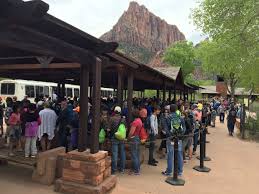
IF YOU CAN ACTUALLY ENTER ZION, YOU WILL LIKELY FACE A LONG WAIT TO BOARD THE PARK SHUTTLE.
(Photo courtesy of TripAdvisor)
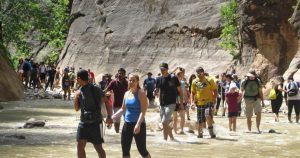
IF YOU ACTUALLY GET ON A SHUTTLE BUS, YOU WILL NOT BE ALONE ON THE TRAIL.
(Photo courtesy of TripAdvisor)
Crowds at Zion—and many other national parks—have become unmanageable, jeopardizing the natural experience the parks were created to provide. This new normal will only get worse. What can be done?
SOLUTIONS—Changes must be made if our parks are going to remain places of special importance.
- It is a harsh and perhaps unpleasant reality, but if the parks are to be saved, use must be limited. The National Park Services realizes that a reservation system, unpopular as it will be, is long overdue. Entrance and/or parking reservations would set limits on visitor numbers.
- Reduce automobile traffic by requiring visitors to ride shuttle buses within park boundaries.
- Use a lottery system to manage numbers of hikers on popular trails.
- Mount an advertising campaign that will encourage non-summer travel to the national parks.
- Promote social media responsibility when posting pictures. (Example: Don’t include GPS coordinates that share the precise location of the photo and don’t take dangerous selfies.)
- Visit lesser known parks and scenic areas: Grand Staircase-Escalante National Monument (UT) instead of Zion (UT); Snowy Range Scenic Byway (WY) instead of Rocky Mountain National Park (CO); or, Absaroka-Beartooth Wilderness Area (MT) instead of Yellowstone (WY).
Any of us who have visited our national parks have contributed to this escalating crisis. We must all be part of the solution if our parks are to remain an enduring part of this country’s heritage. Something must be done if our parks are to remain places of special importance for future generations. There is no choice.

